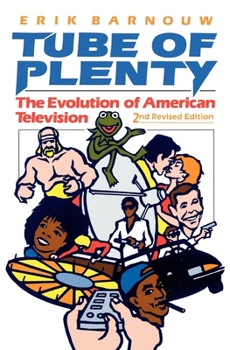Tube of Plenty: The Evolution of American Television, 2nd Edition
Select Format
Select Condition 
Book Overview
Based on the classic History of Broadcasting in the United States, Tube of Plenty represents the fruit of several decades' labor. When Erik Barnouw--premier chronicler of American broadcasting and a participant in the industry for fifty years--first undertook the project of recording its history, many viewed it as a light-weight literary task concerned mainly with "entertainment" trivia. Indeed, trivia such as that found in quiz programs do appear...
Format:Paperback
Language:English
ISBN:0195064844
ISBN13:9780195064841
Release Date:May 1990
Publisher:Oxford University Press, USA
Length:624 Pages
Weight:1.00 lbs.
Dimensions:1.2" x 5.3" x 8.0"
Customer Reviews
2 ratings
Essential for understanding the development of TV as a business and technology
Published by Thriftbooks.com User , 17 years ago
This is a generous single-volume condensation of Erik Barnouw's seminal three-volume HISTORY OF BROADCASTING IN THE UNITED STATES. It is not a perfect book--took much is left out for that--but it does provide any student of American TV with an essential overview of many aspects in the birth and development of the medium. Despite the great length of the book, even in the single-volume abridgment, there are some curious omissions, but the strong points of the book are very strong indeed and make the book one of the crucial volumes for any personal library on television. Barnouw tells in wonderful (and wonderfully entertaining) detail the development of the technologies that allowed the existence of radio and television, as well as the economic realities that turned it into the massive business that it has long been. He also explores the political aspects of the medium, both in terms of serving as part of the Fourth Estate by providing oversight to government actions and policies, and the erosion of that role as right wing groups have undermined that role (Barnouw anticipates the ultimate melding of right wing politics and corporate owned media, while at the same time crying crocodile tears over the mythical liberal media). He is also exceptional at detailing what kinds of shows arose at what time and what the constituent factors were. Even if one has a pretty decent idea of what was happening on TV at what time, Barnouw will both broaden and deepen one's understanding of the medium. Nonetheless, while this is an outstanding book, one can't help but be struck by what was left out. For instance, there is no mention of a large number of seminal television shows. Although one of the most popular shows on TV in the fifties, THE PHIL SILVERS SHOW with Silvers as Sgt. Bilko got no mention at all. THE TWILIGHT ZONE was one of the best-written and iconic shows of all time, yet it is not discussed at all. Though I was never a fan of GILLIGAN'S ISLAND, it was nearly as popular as THE BEVERLY HILLBILLIES, which receives extensive notice. One recognizes that there are time restrictions, but these omissions are significant. There is also an amazing neglect of British Television shows. SECRET AGENT MAN aka DANGER MAN received no mention nor did the massively influential MONTY PYTHON'S FLYING CIRCUS. This all highlights the book's strength. It is far weaker in discussing the aesthetics of TV than examining it as an industry and as a technology. The cut off point for the book is the late eighties, yet not a single word deals with the enormous growth of television as an art form in that decade. The most important show that decade by far was HILL STREET BLUES. Virtually every series (what Barnouw would call a telefilm) in the history of prime time television prior to HILL STREET BLUES adhered to the episodic format, each series consisting of a series of self-contained segments that would resolve all of that week's action and then be forgotten by
This is an exceptional telling of the story of television.
Published by Thriftbooks.com User , 25 years ago
Erik Barnouw tells the story of television from the beginning. It does not begin with Uncle Miltie and I Love Lucy, in fact Milton Berle doesn't appear until page 117. This is a story of television which begins seven decades earlier, when the first piece of the puzzle which would become television was unveiled: the telephone. This, Barnouw recognizes, is the birth of television, because it fired the imaginations of scientists and engineers, artists and entrepreneurs, and, perhaps most importantly, boys plowing fields with their horse teams.The stories of the young geniuses like Marconi and Farnsworth capture the imagination, and Barnouw highlights these heros' struggles in the wars waged by RCA against each of them. Greater attention is due Edwin Howard Armstrong, another young genius who was crushed by the monstrous corporation, but Barnouw gives Armstrong more than most. By the time RCA premieres television service in 1939, the reader understands that television has already had a tremendous impact on America.Television's greatest moments are here, and Barnouw does a excellent job of devoting appropriate amounts of time to each. The author recognizes how interwoven television has become in our society and some chapter breaks are measured by historical events, rather than by eras of television. The end of World War II and the assassination of JFK not only marked shifts in our nation's history, but in television as well. What followed were not historical events, as before TV, but media events. The book also features a very useful and interesting 11-page chronology, an excellent biographical notes section, and an exceptional indexes, all of which make this tremendously accessible. It is tremendously compelling reading. Don't pick it up before your favorite show, because you won't be able to put it down in time!




